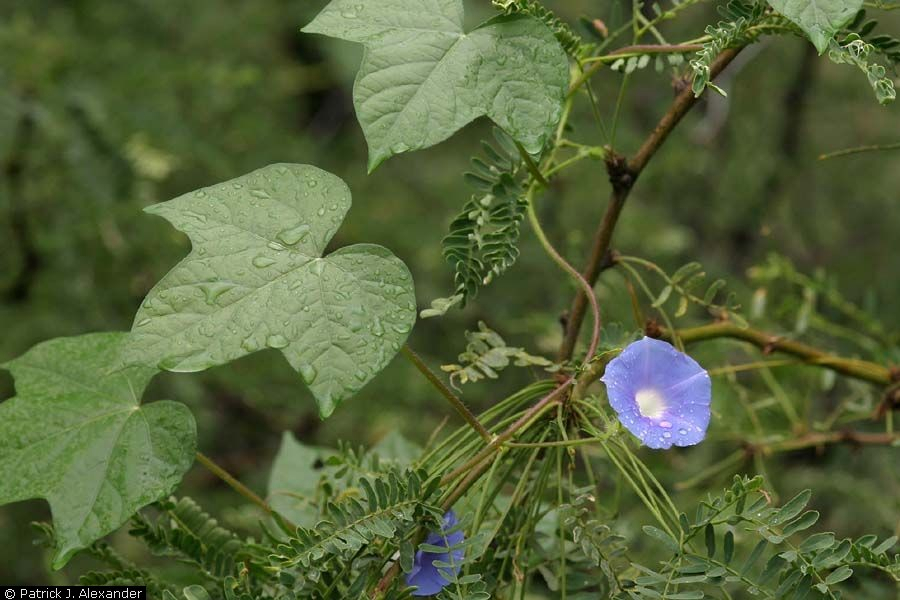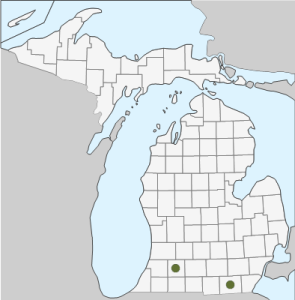 Download PDF
Download PDF
Name: Ipomoea hederacea (L.) Jacquin
Family: Convolvulaceae, the bindweed or morning glory family (15)
Common Names: Small Morning-glory, Ivy-leaf Morning-glory (8,14)
Etymology: Ipomoea comes from the Greek words ips, which means “worm”, and homois, which means “similar to.” Hederaceae means “of or pertaining to ivy” (10).
 Botanical synonyms (14):
Botanical synonyms (14):
Ipomoea barbigera Sweet
Ipomoea desertorum House
Ipomoea hirsutula auct. non Jacq. f. Ipomoea nil auct. non (L.) Roth Pharbitis barbigera (Sweet) G. Don
Pharbitis hederacea (Jacq.) Choisy
Quick Notable Features:
¬ Deeply 3-lobed pubescent leaves
¬ 1-3 purple, white, or rosy flowers on peduncles
¬ Simple, alternate leaves with entire, but lobed margins
¬ Hairy calyx
Plant Height: Usually 1 – 2m tall (5,6), but stems can grow to many meters in length (1).
Subspecies/varieties recognized: Ipomoea hederacea var. hedera, Ipomoea hederacea var. integruiscula (9,12).
Most Likely Confused with: Members of the genus Hedera, Ipomoea coccinea, Ipomoea lacunosa, and Ipomoea purpurea (3,16).
Habitat Preference: I. hederacea is frost intolerant and is commonly found in warmer climates. It thrives in cultivated ground, disturbed areas, and waste places (1,3,5,6,14).
Geographic Distribution in Michigan: I. hederacea is found only in Lenawee and Kalamazoo counties (16).
Known Elevational Distribution: In California, this species is found from 305 to 1,676 m (8).
Complete Geographic Distribution: The species is native to Central America, but has adapted to tropical, subtropical, and warm temperate regions of the world (1). I. hederacea is found in every state from Texas north to North Dakota and east to Maine. New Mexico and Arizona are also included while Vermont is excluded (14).
Vegetative Plant Description: This annual plant has simple, alternate leaves with entire margins. Leaves are ovate and deeply 3-lobed with acuminate tips and cordate bases. They can grow from 3.5-13 cm broad and long. Pubescence occurs on the upper and under surface of the leaves. Petioles grow to more than 12 cm long and the stem is slender and pubescent (3,8,15).
 Climbing Mechanism: Stem twine with their apex in a dextral fashion (5,11).
Climbing Mechanism: Stem twine with their apex in a dextral fashion (5,11).
Flower Description: Inflorescences of 1-3 flowers borne in a cymose cluster. Each division of the inflorescence is subtended by opposite, linear-attenuate bracts. These bracts grow to 3 cm long and 2-3mm broad. The 5-merous flowers are perfect and shorter than the pedicel. The calyx is hairy. The individual sepals are ovate-lanceolate with an apex that is acute to abruptly acuminate. The lobes are shorter to slightly longer than the body. The glabrous, funnel-shaped corollas are purple, white, or rosy varying from 3 to 5 cm long and 1 to 4 cm wide. There are 5 stamens. The superior, conical ovary is 3- locular, pubescent, grows to about 1mm long and bears one style with a 3-lobed globular stigma. Stamens and styles are shorter than the corolla tube (1,3,8,9,15).
Flowering Time: In the northeastern U.S.A, the plant flowers from July to September (8).
Pollinator: Ipomoea hederacea is commonly pollinated by long-tongued bumblebees (4).
Fruit Type and Description: The fruit is a depressed-globose capsule ranging from 8 to12 mm in diameter. It is glabrous, 3-celled, and contains 1-6 seeds (15,17).
 Seed Description: The seeds range from 4.5 to 6 mm long and vary from shades of black to dull grey. They are densely pubescent with hairs in irregular patches, and weight about 34 mg (8,16, 19).
Seed Description: The seeds range from 4.5 to 6 mm long and vary from shades of black to dull grey. They are densely pubescent with hairs in irregular patches, and weight about 34 mg (8,16, 19).
Dispersal Syndrome: Seed dispersal is by wind and rain action, and gravity. Seeds also can be spread by birds, and by human activities by way of contaminated crop and flower seeds (15).
Distinguished by: Ipomoea coccinea has a similar height to I. hederacea and both grow tangled in amongst other Ipomoea species. Once in flower, they are easily distinguished as Ipomoea coccinea has a dark orange to red salverform corolla and Ipomoea purpurea and I. hederacea both have light blue to purple funnelform corollas. Ipomoea purpurea and Ipomoea hederacea are distinguishable by sepal characteristics and leaf characteristics. Ipomoea purpurea’s sepals are ovate-lanceolate with an apex that is acute to abruptly acuminate. The lobes are shorter to slightly longer than the body. I. hederacea’s sepals are lanceolate, long-attenuate, and caudate. The sepal lobes are much longer than the body. Species in the genus Hedera have two leaf types: palmately lobed juvenile leaves and unlobed cordate adult leaves. Hedera’s green-yellow flowers produced in late autumn are borne in 3–5 cm diameter umbels unlike Ipomoea hederacea (large purple, white, or rosy funnelform corollas). Fruits of species in the genus Hedera are small black berries while the fruit of I. hederacea is a depressed-globose capsule. Ipomoea lacunosa typically has a white corolla with pink to purple anthers. The flowers are typically single or double in axillary position, unlike Ipomoea hederacea, which has 1-3 flowers in a cymose inflorescence (15).
Other members of the family in Michigan: Calystegia (10 species), Convolvulus (2 species), and Ipomoea (4 species) (14).
 Ethnobotanical Uses: This species is cited as being used as an abortifacient, anthelminthic, cathartic, deobstruent, diuretic, purgative, vermifuge, and vision medication (2).
Ethnobotanical Uses: This species is cited as being used as an abortifacient, anthelminthic, cathartic, deobstruent, diuretic, purgative, vermifuge, and vision medication (2).
Phylogenetic Information: The Convolvulaceae are a member of the order Solanales. The Solanales form a monophyletic group with Lamiales and belongs to Asterid I angiosperms. Within Convolvulaceae there are 3 or 4 distinct subfamilies. Ipomoea belongs to the Convolvuloidae (11,18).
Literature and websites used:
- Missouriplants.com: Photographs and descriptions of the flowering and non-flowering plants of Missouri, USA. http://www.missouriplants.com/index.html Compiled by Dan Tenaglia. Accessed: December 4, 2008. Last Updated: February 8, 2007.
- Duke, J.A. Dr. Duke’s Phytochemical and Ethnobotanical Databases. Last Modified: March 10, 1998. http://www.ars-grin.gov/duke/
- Fernald, M.L. 1950. Gray’s Manual of Botany, 8th ed. New York, USA: American Book Company.
- Hilty, J. Insect Visitors of Illinois Wildflowers. Last updated: August 13, 2008. http://www.shout.net/~jhilty
- Gleason, H.A. 1963. The New Britton and Brown Illustrated Flora of the Northeastern United States and Adjacent Canada. New York, New York, USA: Hafner Publishing Co., Inc.
- Gleason, H.A. and A. Cronquist. 1991. Manual of Vascular Plants of the Northeastern United States and Adjacent Canada. Bronx, New York, USA: New York Botanical Garden Press
- Ipomoea hederacea Jacq. State of Michigan Prohibited and Restricted Weeds, 2001-2008. http://www.michigan.gov/mda/0,1607,7-125-1569_16993-11250–,00.html
- Kendall, W.T. 2005. KES Species Distribution List for Township 16 South, Range 12 East, Pima County Arizona. Gila and Salt River Baseline and Meridian. Last updated September 20, 2005. http://www.pima.gov/cmo/sdcp/species/TR/T16S_R12E.htm
- Parkhurst, H.E. 1903. Trees, shrubs and vines of the northeastern United States. New York, New York, USA: C. Scribner’s Sons.
- Radford, A.E., H.E. Ahles, and C.R. Bell. 1968. Manual of the Vascular Flora of the Carolinas. Chapel Hill, North Carolina, USA: The University of North Carolina Press.
- Robert W. Freckmann Herbarium. University of Wisconsin- Stevens Point.http://wisflora.herbarium.wisc.edu/taxa/index.php?taxon=3938
- Stevens, P.F. Angiosperm Phylogeny Website. Version 7, May 2006.http://www.mobot.org/MOBOT/research/APweb
- The International Plants Name Index, 2004 – 2006. Last updated: December 2006. http://www.ipni.org/index.html
- USDA, NRCS. 2008. The PLANTS Database, Version 3.1, National Plant Data Center, Baton Rouge, Louisiana. http://plants.usda.gov/ (October 28,2008)
- Halvorson, W.L. USGS Weeds in the West project: Status of Introduced Plants in Southern Arizona Parks. Tucson, Arizona. http://sdrsnet.srnr.arizona.edu/data/sdrs/ww/docs/ipom_spp.pdf
- Voss, E.G. 2004. Michigan Flora Part III: Dicots Concluded. Ann Arbor, Michigan, USA: Cranbrook Institute of Science.
- Weeds and Plant Identification of Diagnostic Services at Michigan State University. 2006. Species page for Ipomoea hederacea. http://www.pestid.msu.edu/Default.aspx?tabid=112
- Zomlefer, W.B. 1994. Guide to Flowering Plant Families. Chapel Hill, North Carolina, USA: The University of North Carolina.
- McConnaughay, K.D.M. and F.A. Bazzaz 1987. The relationship between gap size and performance of several colonizing annuals. Ecology 68(2): 411-416
Image Credits (all used with permission):
1) Image of flower in habit, copyright and courtesy of Patrick J. Alexander.
2) Image of flowers and leaf copyright and courtesy of T. Beth Kinsey from http://www.fireflyforest.com/flowers/.
3) Image of seeds copyright by Steve Hurst @ USDA-NRCS PLANTS Database
4) Species distribution map, derived from the Michigan Flora Online.
Primary Authors: Ashley Erwin and John Bradtke, with editing by ReBecca Sonday and Robyn J. Burnham
© Robyn J. Burnham, University of Michigan
For additional information on Michigan Plant Diversity web pages please contact Robyn J. Burnham via email: rburnham“at”umich.edu